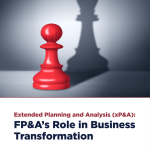In this blog we explain how companies can efficiently and accurately calculate their personnel requirements.

What is an organisation’s most vital asset? Talent, otherwise known as human capital. That makes workforce planning particularly important: a thoughtful and integrated approach to workforce planning creates a competitive advantage.
There is a competitive advantage to a thoughtful approach to workforce planning. xP&A (Extended Planning and Analysis) can be defined as collaborative planning. It demands that FP&A individuals have the capability and desire to work co-operatively, multi-dimensionally and at different levels of the organisation. It represents a complete transformation of FP&A, which goes beyond a mere finance function to do so much more: continually challenge the status quo, educate, and shape and influence management decisions.
This article highlights the immense benefits of one of the important aspects of xP&A – an integrated workforce planning approach. Let’s examine some of the challenges this approach seeks to address.
The Challenges of a Manual Environment
Headcount costs represent one of the most significant expense lines for most companies. However, FP&A professionals often dread the possibility of questions concerning headcount assumptions and costs. And with good reason! When it comes to providing information to managers, workforce or headcount planning is one of the trickiest areas.
Why is it so hard to get quality information for this critical part of a business? The reasons include:
-
Financial and HR systems are not integrated
For FP&A professionals, this means going back and forth with HR to understand assumptions. Data are often traced back to detailed Excel sheets that are frequently found to be obsolete. Headcount in organisations is constantly in flux, and a manual process makes it virtually impossible to stay on top of.
-
Communication challenges and delays between functions
FP&A and Human Resources have different financial comprehension levels, which makes seamless communication challenging. This gap results in delays in obtaining quality information.
The Top Three Benefits of Integrated Workforce Planning
In light of the above challenges, it’s no wonder that FP&A professionals would find the thought of an integrated workforce planning model appealing. Imagine being able to answer the CEO or CFO’s questions on the fly using dynamic reporting, including the financial implications! The benefits of integrated workforce planning include:
- Allowing an organisation to understand current headcount challenges and opportunities and make real-time decisions to help itself thrive. For example, organisations are currently facing significant challenges post-Covid. Workers now have many options, including staying home and seeking government assistance.
- Helping management to understand regional issues and specificities, rather than being trapped in only understanding the high-level organisational statistics. One company I worked for had a regional problem where absenteeism and resignations were high. Obtaining the data behind this problem was very time-consuming in a manual environment. An integrated model where the site could provide on-demand reporting would have made all the difference.
- When playing scenarios, integrated workforce planning can help organisations proactively develop HR strategies and understand the financial implications of those. Extending this to the strategic plan reaps even more benefits. Organisations can proactively assess skill gaps, ensure they have plans to address them and hire the optimal talent level.
Implementing Integrated HR Planning
Knowing the huge benefits of integrated HR planning, you’re probably wondering how we can implement it? Critical factors determining implementation success include:
- Investment in cultural transformation, including Change Management. It must start with senior management and extend to all organisational team members.
- A proper collaborative approach. FP&A and HR professionals must collaborate effectively and build trust with cross-functional partners. Joint accountability is particularly important.
- Rethinking the annual budgeting process. FP&A should think of this approach as extending well beyond the annual budget cycle. This involves regular interactions and meetings with all stakeholders involved in integrated HR planning.
In summary
As talent competition intensifies, organisations that invest in integrated workforce planning will have a significant advantage. With this crucial aspect of xP&A, organisations can proactively develop strategies to ensure their workforce is staffed appropriately, with the talent to deliver the highest ROI for their company.
This article was first published on SAP blog.
Subscribe to
FP&A Trends Digest

We will regularly update you on the latest trends and developments in FP&A. Take the opportunity to have articles written by finance thought leaders delivered directly to your inbox; watch compelling webinars; connect with like-minded professionals; and become a part of our global community.




